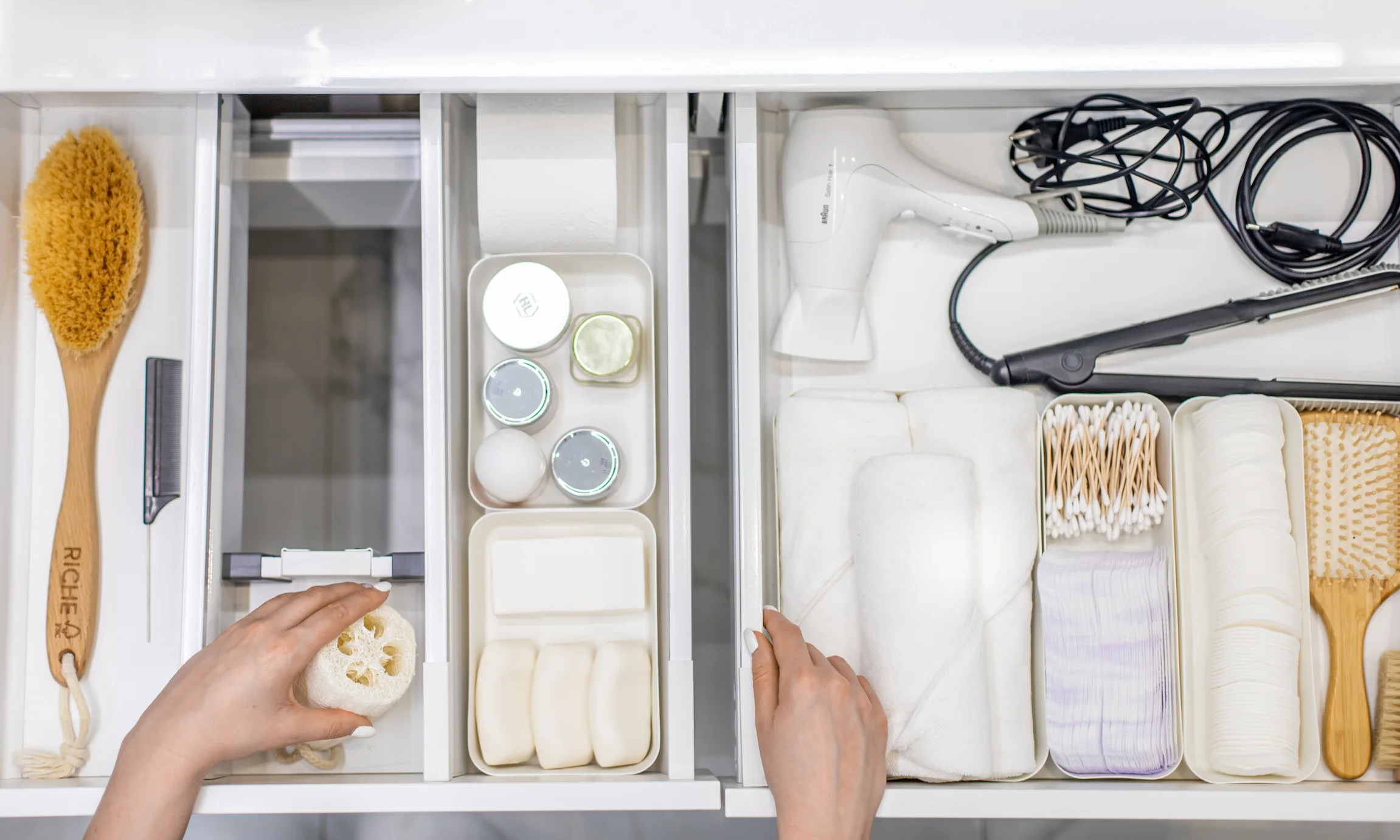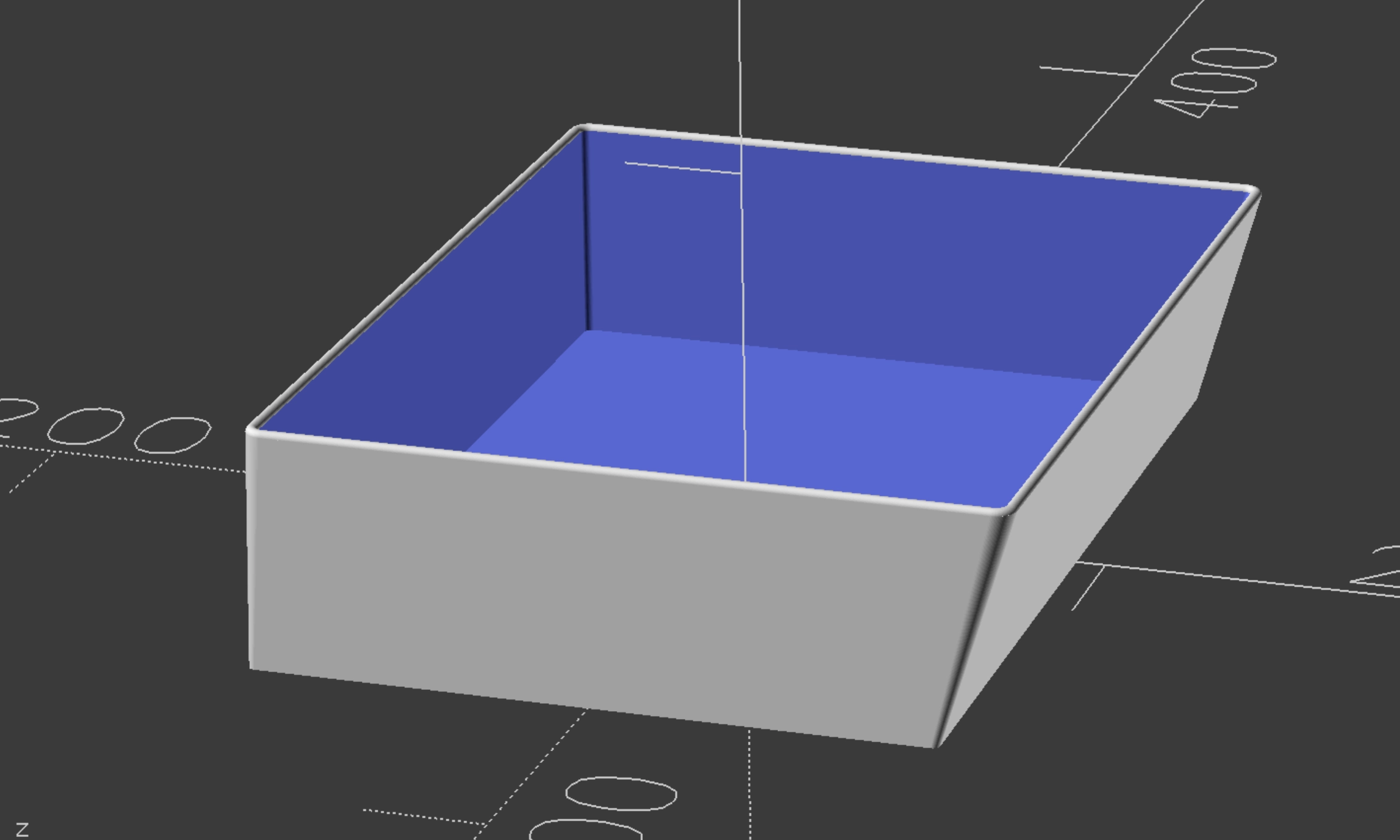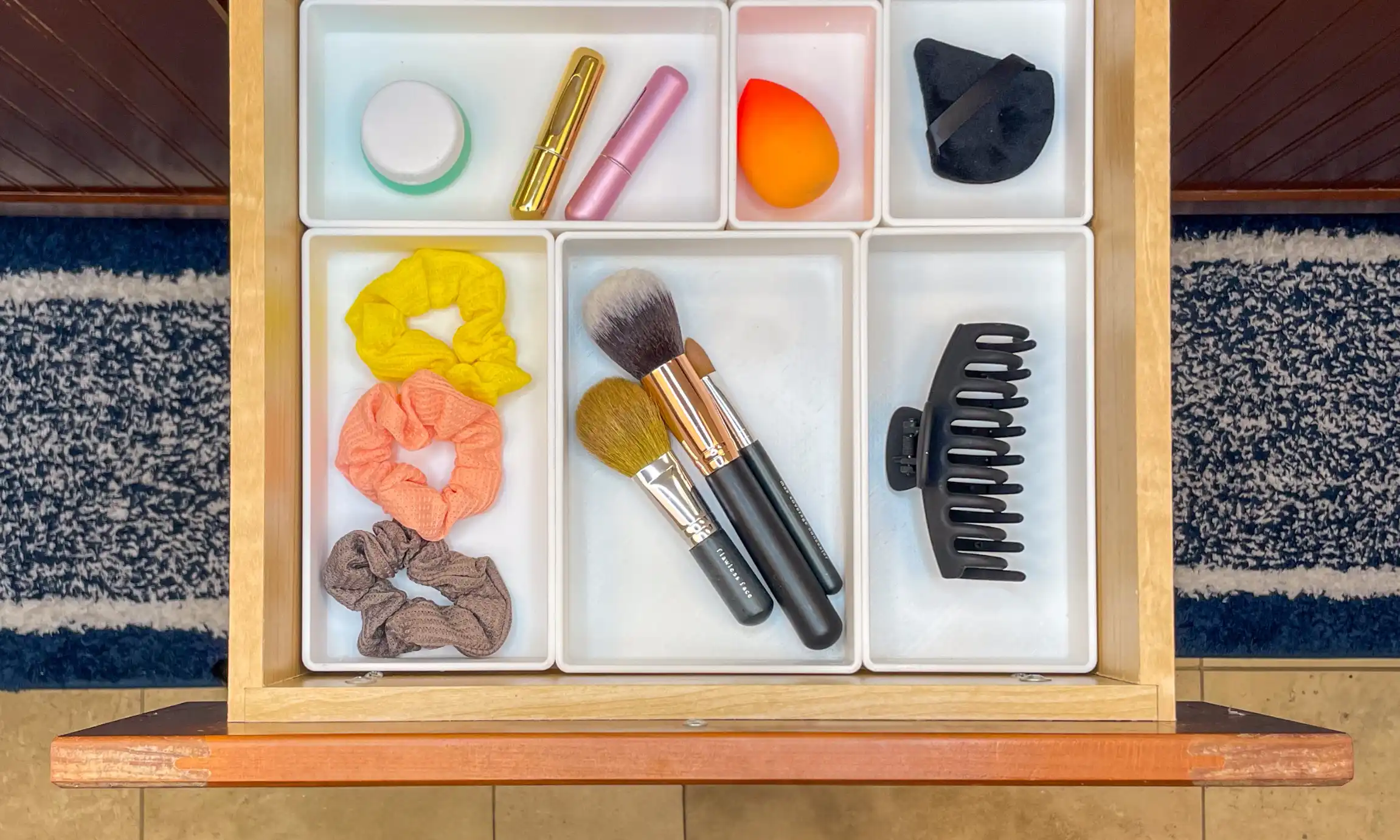
Drawers are sneaky. They start out innocent—a place to keep your nightly lip balm, the good scissors, or that one phone charger you actually like. Then one day, you open one and it’s turned into a fully operational lost-and-found.
This is your rescue plan. We’ve pulled the best drawer organization ideas from professional organizers who have seen it all—nightstands stuffed with receipts, kitchen drawers hiding unopened mail, desk drawers acting like Bermuda Triangles for office supplies.
We’ll start with the universal tips that apply to every drawer in your home. Then we’ll go space by space, with quick overviews and direct quotes from the pros, plus links to detailed guides if you’re ready to go deeper.
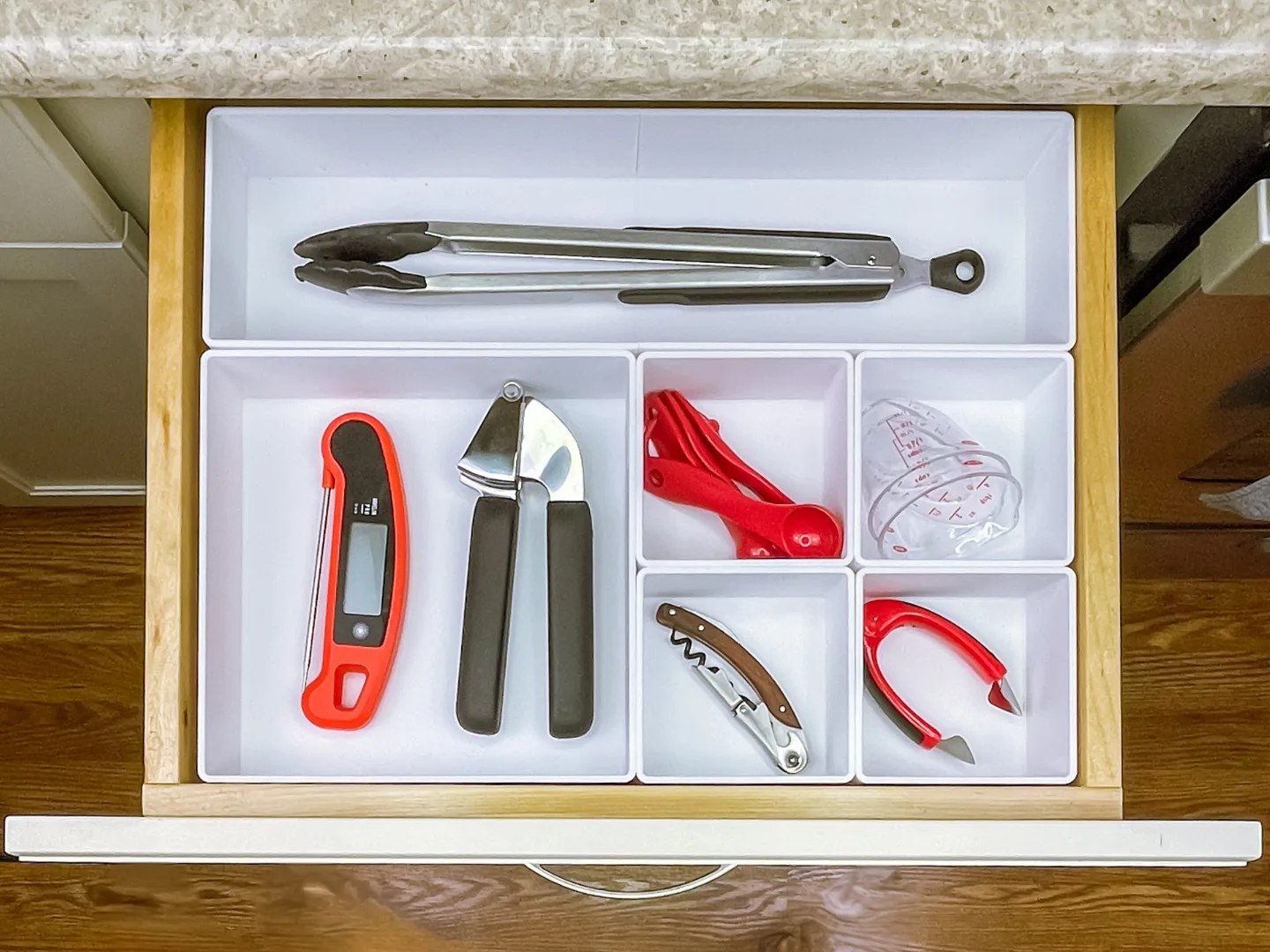
Every messy drawer has the same origin story: a little too much stuff, a little too little time, and a habit of tossing things in ‘just for now.’ The good news? A few simple habits can stop the cycle and work in any drawer, no matter the room.
The first fix is universal: empty it completely. No mercy, no half-measures—if it’s staying, it has to earn its spot back. From there, group what’s left into broad, obvious categories. As multiple pros reminded us, too many micro-categories is just another form of overthinking.
Once you know what’s actually living there, assign prime real estate to the things you grab most often. Everyday items go up front; backups and occasional-use tools can take the backseat. And yes, this applies whether we’re talking about mixing bowls or sticky notes.
The system only works if it’s easy to maintain, so make storage do the heavy lifting. Drawer inserts, adjustable dividers, small trays, and custom organizers keep everything in place—and keep you from starting over in three months. Label if you need to (even discreetly), and commit to a quick weekly reset before things slide back into chaos.
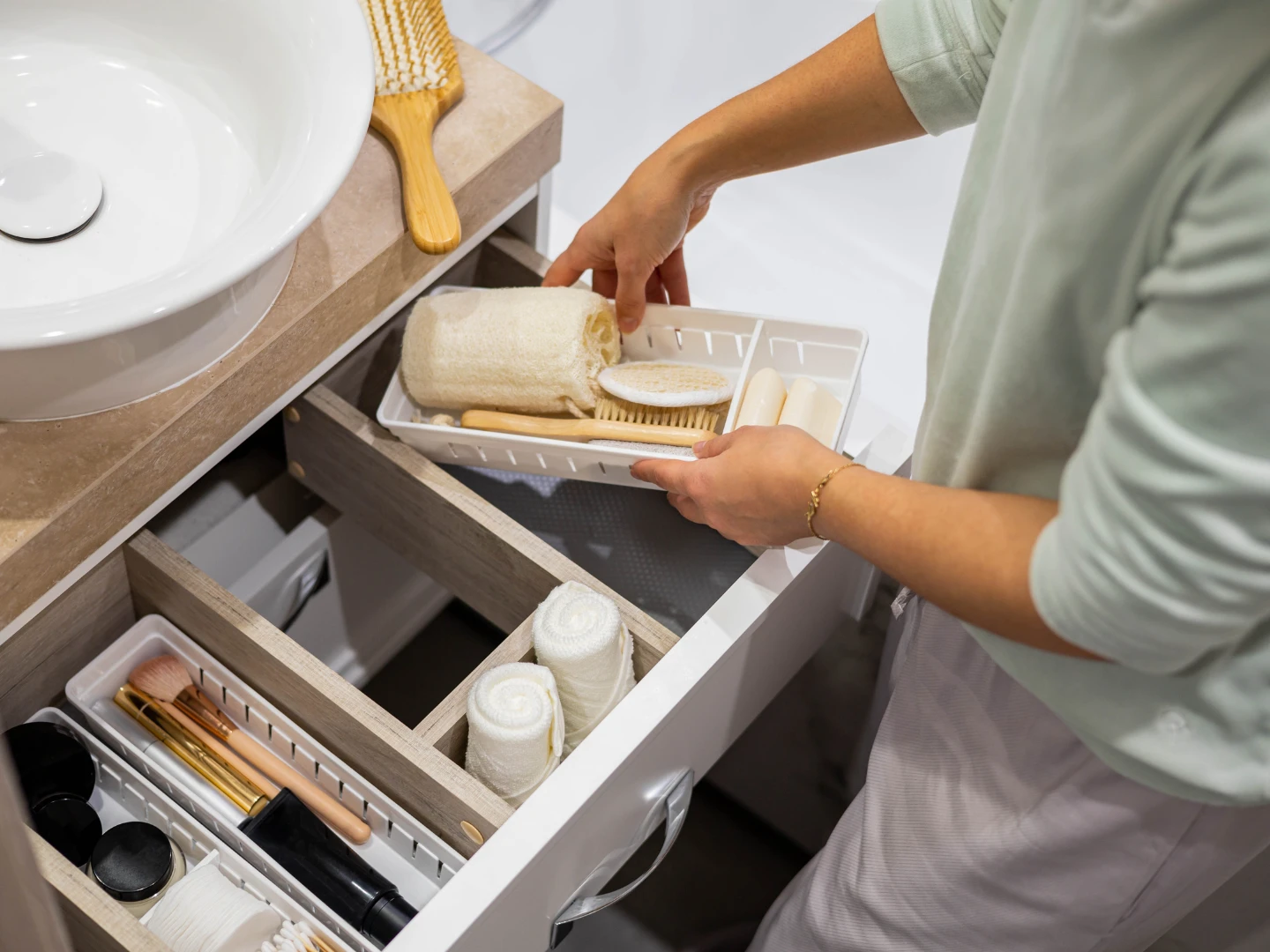
Bathroom drawers may be small, but they’re magnets for clutter—skincare bottles rolling around with lipsticks, hair tools jammed in with toothpaste, and backups shoved in wherever they’ll fit. Professional Organizer Kristen Donnino has a system to keep them from turning into chaos zones.
Kristen keeps it simple: “Items used daily—like toothbrushes, razors, or go-to makeup—should live in the top drawers where they’re easily accessible.” Backups and travel products belong under the sink so they don’t clog daily space.
The easiest way to make mornings and nights run smoother is to organize by ritual. Kristen sets up one zone for morning skincare, another for evening, with makeup split into face, eyes, and lips, and hair tools in their own section. A heat-safe liner is a bonus if you store hot tools before they’ve cooled.
Sliding bins are the enemy. Kristen swears by custom-fit organizers that maximize every inch and keep categories from drifting. She also suggests keeping bulk purchases out of the drawer. “Think of it like a mini store,” she says—set up a labeled backstock bin under the sink or in a closet, and refill as needed.
Want the full breakdown, plus Kristen’s hacks for labels, dividers, and Sunday resets? Check out our complete guide on how to organize bathroom drawers.

Nightstands are supposed to be a bedtime ally. Instead, yours has turned into a chaotic side hustle for receipts, dead chargers, and the world’s stickiest lip balm.
As Professional Organizer Missy Feldman puts it, “One of the most common mistakes people make when organizing their nightstands is turning them into catch-all spaces.” And if you’ve ever had to excavate a phone charger from under a pile of mementos with no real purpose, you know she’s right.
The fix starts with brutal honesty: clear out anything that doesn’t directly serve your nighttime routine. Keep it minimal—sleep mask, lip balm, maybe a notepad for late-night ideas.
Surfaces get the same treatment: one lamp, one decorative touch, one actual-use item. Anything else? It’s just a future spill waiting to happen.
Once you’ve streamlined, use organizers to keep categories contained and drawer space sacred. Missy’s mantra—keep it simple and consistent—isn’t just a rule, it’s how you keep chaos from crawling back in.
Want the full breakdown of products, placement strategies, and long-term maintenance? Check out our complete guide to nightstand organization.

Deep kitchen drawers can feel like a blessing… until you realize you’ve accidentally turned them into a black hole for dog treats, birthday candles, and unopened mail.
As Professional Organizer Tracey Showalter reminds us, “The kitchen is the most valuable real estate in the house.” Translation: stop wasting prime space on things that have nothing to do with cooking.
The fix is to give that vertical space a real job. Store bulky, hard-to-place kitchen items—pots, plates, tall pantry containers, even small appliances—rather than random clutter. Use dividers or a custom insert to create a grid, with your most-used items in the front and less-used ones in the back.
Tracey’s “grid system” is the difference between a drawer you open with dread and one that actually makes meal prep faster. Label container tops, group by category, and create zones so each drawer becomes a station—baking, coffee, snacks—whatever makes your kitchen flow better.
Want to see how to set up these zones and the products that make them work? Head to our full guide on deep kitchen drawer organization.

The junk drawer: part time capsule, part chaos experiment, and all frustration.
According to Professional Organizer Melanie Summers, a junk drawer is “a holding zone for indecision.” It fills with the stuff you might use someday, plus all the odds and ends you couldn’t be bothered to put away properly.
Melanie’s fix is simple: make putting things back easier than dumping them in randomly. Empty it completely, clean it out, and group what stays into 3–5 broad categories—think tools, office supplies, tech, household items. Anything that doesn’t fit gets moved, labeled, or tossed.
The game-changer? Giving every item a defined home with organizers built to fit. As Melanie says, “They’re built to fit exactly what you need, eliminating wasted space and giving every item a clear home.” Keep it up with quick weekly resets and a strict “one in, one out” rule.
Want the full nine-step process with every pro tip included? Read our complete guide to organizing your junk drawer.

Craft supplies are the ultimate double-edged sword—equal parts inspiration and chaos.
Professional Organizer Emily Bell starts every craft supply project with three questions: “What kind of crafts do you actually do? How do you like your space to function? What kind of space are you working with?” Without those answers, you’re just throwing containers at the wall.
Once you’ve defined your needs, pull everything out and sort it—yes, even the “random bits” bin. Group by type, use, or project, then store each category with intention. Drawer inserts, divided trays, clear jars, toolboxes, and pegboards keep the little stuff visible and under control.
If you’re short on space, Emily swears by vertical storage, rolling carts, and multi-use furniture. And for projects in progress, dedicate a specific, labeled spot—no more losing track of half-finished work.
Want the full list of product recs and space-saving hacks? Check out our complete guide to organizing craft supplies.

Desk drawers have a bad habit of turning into a Bermuda Triangle for office supplies.
Professional Organizer D’Nai Walker starts by emptying the whole thing—no shortcuts—and deciding exactly what earns a spot. “It’s always beneficial to first determine what is actually supposed to live in the drawer, that way… only the appropriate things return.”
The top drawer is for daily essentials. Bottom drawers can hold backups and rarely used items. Before you buy organizers, figure out your categories—pens, clips, cables, notepads—so you know exactly what storage you need. Modular systems are great, but measure first, especially for shallow drawers.
Weird-shaped or rarely used items? Store them elsewhere. And if you’re sharing the drawer with family or coworkers, subtle labels inside the drawer can keep everyone on the same page without killing the aesthetic.
Want more category ideas, product suggestions, and real-life desk setups? See our full guide on desk drawer organization.
Drawer clutter doesn’t discriminate—it will happily take over your nightstand, your kitchen, your desk, and your creative space. The trick is to stop treating drawers like a holding pen for indecision and start seeing them as the prime real estate they are.
Declutter, categorize, contain, maintain. Follow those steps and you’ll never have to dig past expired batteries and mystery keys just to find a pen again.
